1992 VOLKSWAGEN TRANSPORTER tow
[x] Cancel search: towPage 61 of 164
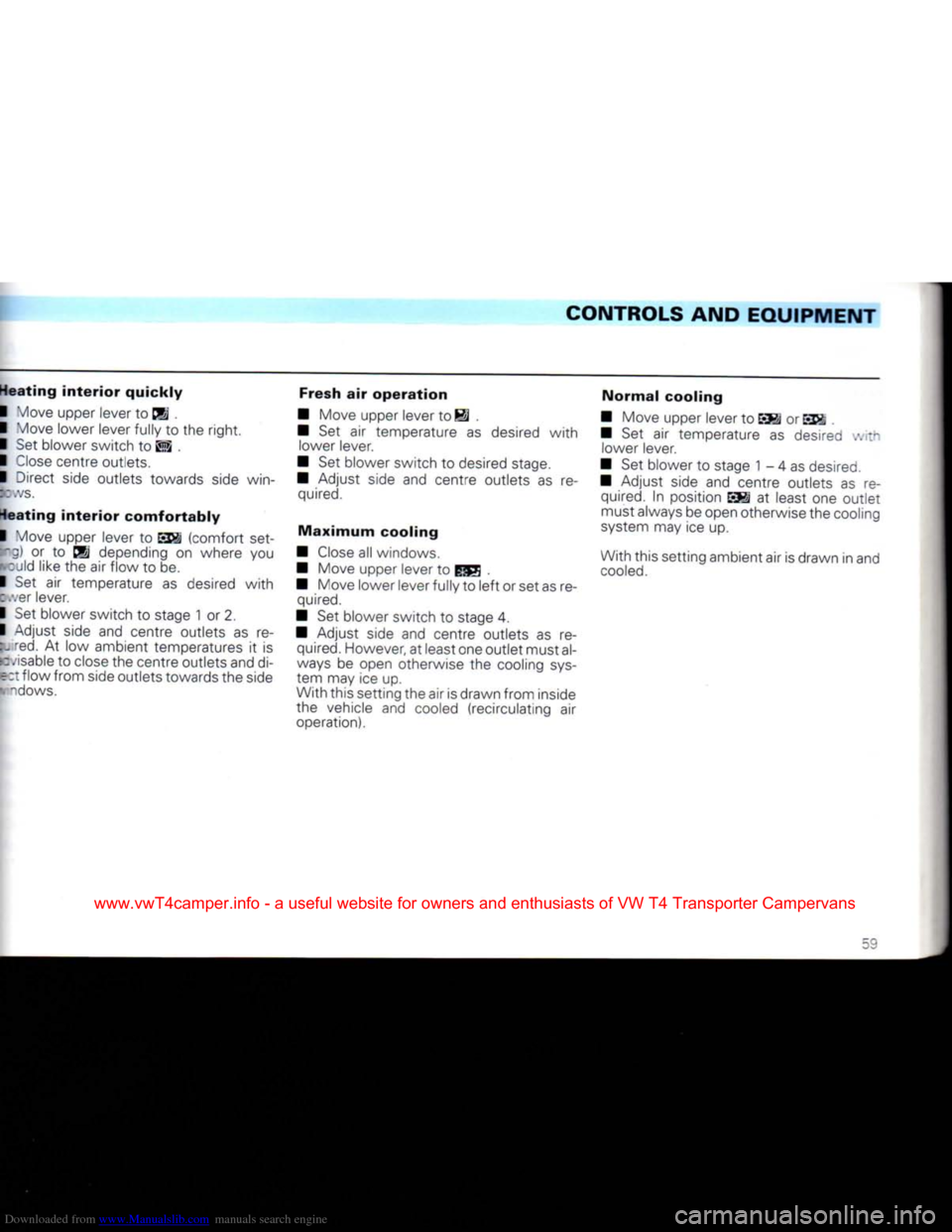
Downloaded from www.Manualslib.com manuals search engine
CONTROLS
AND
EQUIPMENT
Heating
interior
quickly
I Move upper lever to . I Move lower lever fully to the
right.
I Set blower switch to E3 .
I
Close
centre outlets.
I Direct side outlets towards side win-
5:
.vs.
•(eating
interior
comfortably
I Move upper lever to SSi (comfort set 's) or to CS depending on where you
• : jId like the air flow to be.
I Set air temperature as desired
with
: .ver lever.
I Set blower switch to stage 1 or 2.
I Adjust side and centre outlets as re-
:. 'ed. At low ambient temperatures it is
cvisable
to close the centre outlets and di-
ect flow from side outlets towards the side
I ndows. Fresh air
operation
• Move upper lever to
EH
.
• Set air temperature as desired
with
lower lever.
• Set blower switch to desired stage.
• Adjust side and centre outlets as re
quired.
Maximum
cooling
•
Close
all windows. • Move upper lever to •
• Move lower lever fully to
left
or set as re
quired.
• Set blower switch to stage 4.
• Adjust side and centre outlets as re
quired.
However, at least one
outlet
mustal-
ways
be open otherwise the cooling
sys
tem may ice up.
With this setting the air is drawn from inside
the vehicle and cooled (recirculating air operation).
Normal
cooling
• Move upper lever to EM or
ESS*
.
• Set air temperature as desired .-. :~ lower lever.
• Set blower to stage 1 - 4 as desired.
• Adjust side and centre outlets as re
quired.
In position EM at least one
outlet
must always be open otherwise the cooling
system
may ice up.
With this setting ambient air is drawn in and
cooled.
www.vwT4camper.info - a useful website for owners and enthusiasts of VW T4 Transporter Campervans
Page 75 of 164
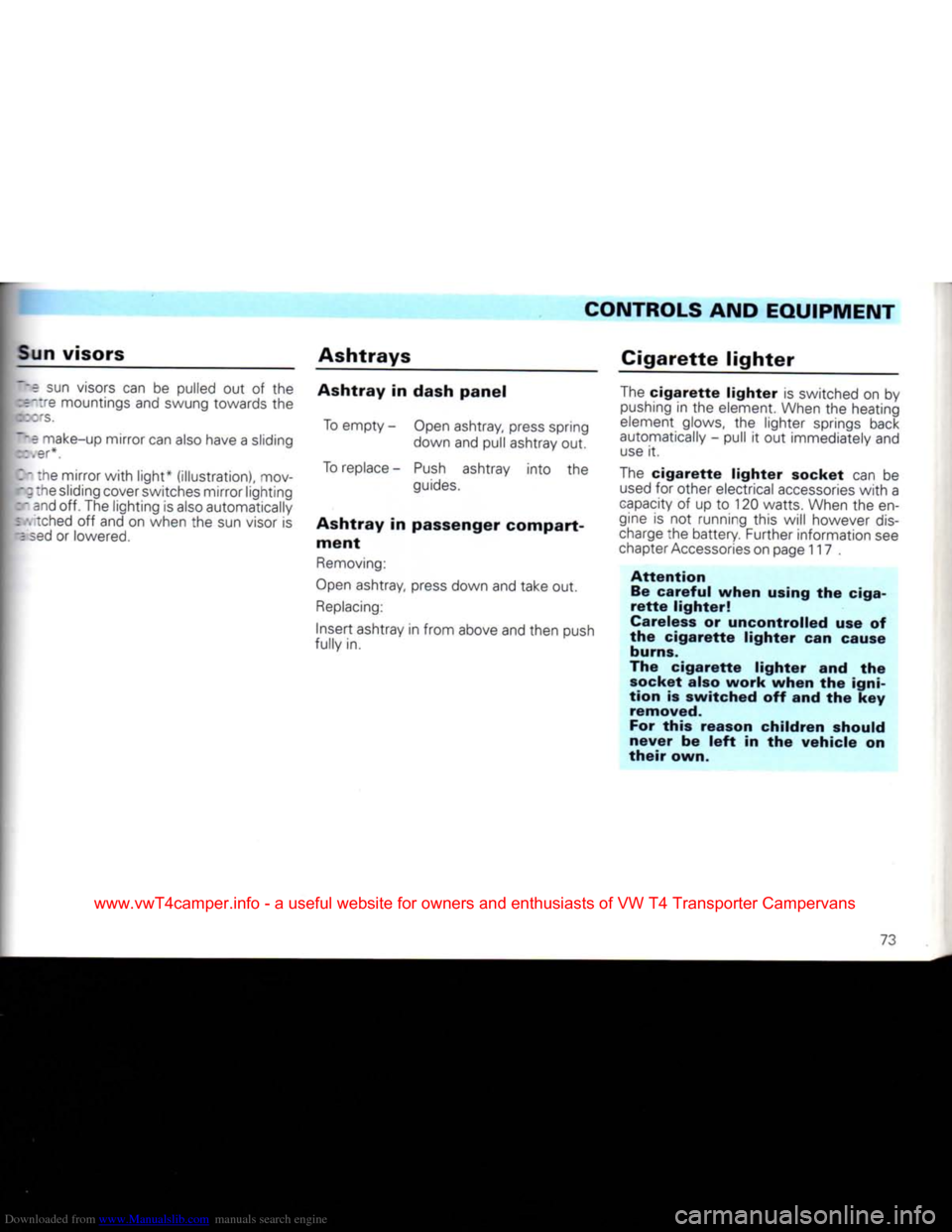
Downloaded from www.Manualslib.com manuals search engine
Sun visors
Ashtrays CONTROLS AND EQUIPMENT
Cigarette
lighter
•= sun visors can be pulled out of the
x~:re mountings and swung towards the
*
i
z
'S.
"*"
e
make-up mirror can also have a sliding
'." :he mirror
with
light* (illustration), mov-•: :ne sliding cover switches mirror lighting
:" and off. The lighting is also automatically
= '. iched off and on when the sun visor is
'= sed or lowered. Ashtray in dash
panel
To
empty - Open ashtray, press spring down and pull ashtray out.
To
replace -
Push
ashtray into the
guides.
Ashtray in passenger
compart
ment
Removing:
Open
ashtray, press down and take out.
Replacing:
Insert ashtray in from above and then push
fully in.
The
cigarette
lighter
is switched on by
pushing in the element. When the heating
element glows, the lighter springs back
automatically - pull it out immediately and
use
it.
The
cigarette
lighter
socket can be
used
for other electrical
accessories
with
a
capacity
of up to 120 watts. When the en
gine is not running this will however dis
charge
the battery. Further information see
chapter
Accessories
on page 117 .
Attention
Be
careful
when
using the ciga
rette
lighter!
Careless or
uncontrolled
use of
the
cigarette
lighter
can cause burns.
The
cigarette
lighter
and the socket also
work
when
the igni
tion
is
switched
off and the key removed.
For
this
reason
children
should
never
be
left
in the
vehicle
on
their
own.
73
www.vwT4camper.info - a useful website for owners and enthusiasts of VW T4 Transporter Campervans
Page 76 of 164
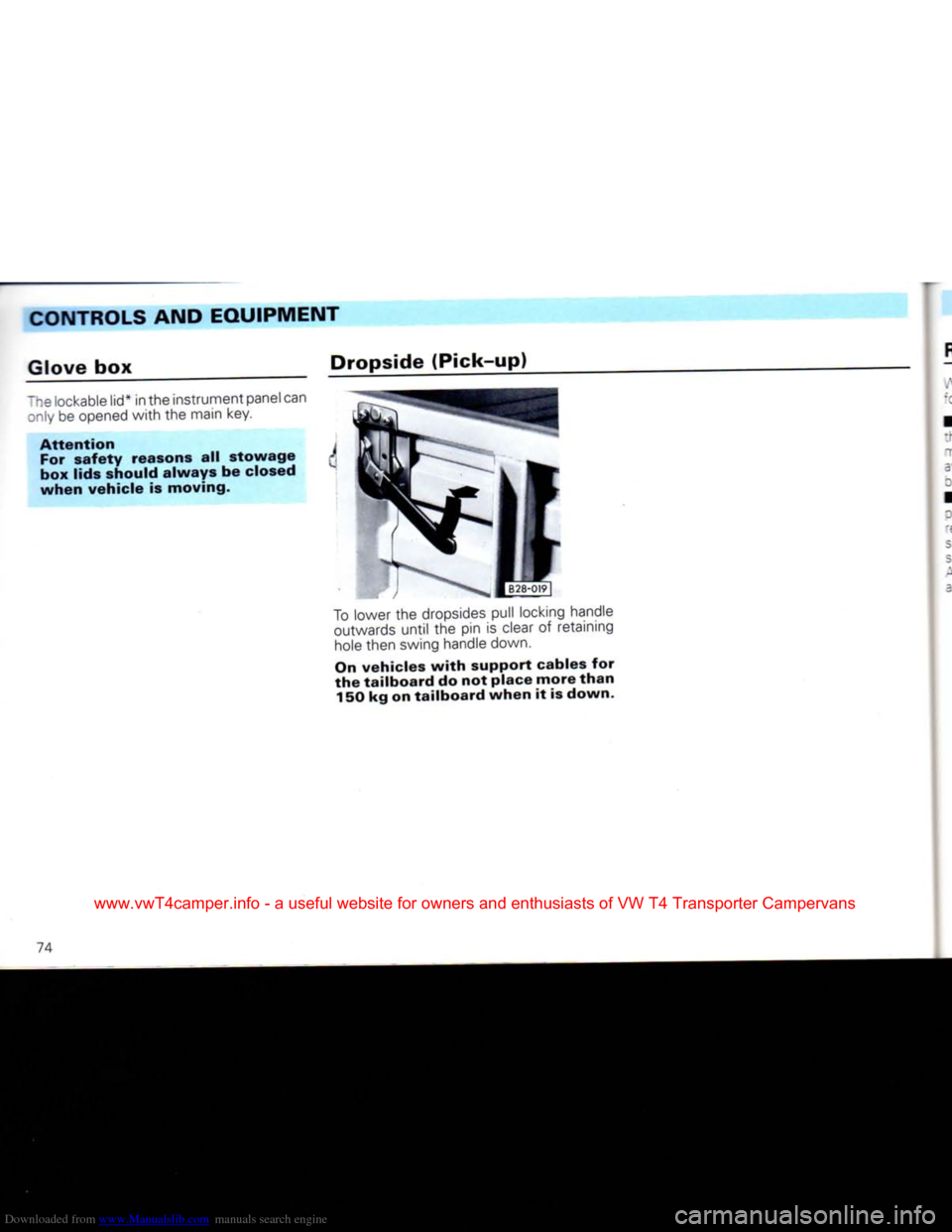
Downloaded from www.Manualslib.com manuals search engine
CONTROLS AND
EQUIPMENT
Glove box
Dropside
(Pick-up)
ns lockable
lid*
in the instrument panel can
only be opened with the main key.
Attention For safety reasons all stowage
box lids should always be closed
when vehicle is moving.
To lower the dropsides pull locking handle outwards until the pin is clear of retaining hole then swing handle down.
On vehicles with support cables for
the tailboard do not place more than 150 kg on tailboard when it is down.
74
www.vwT4camper.info - a useful website for owners and enthusiasts of VW T4 Transporter Campervans
Page 78 of 164
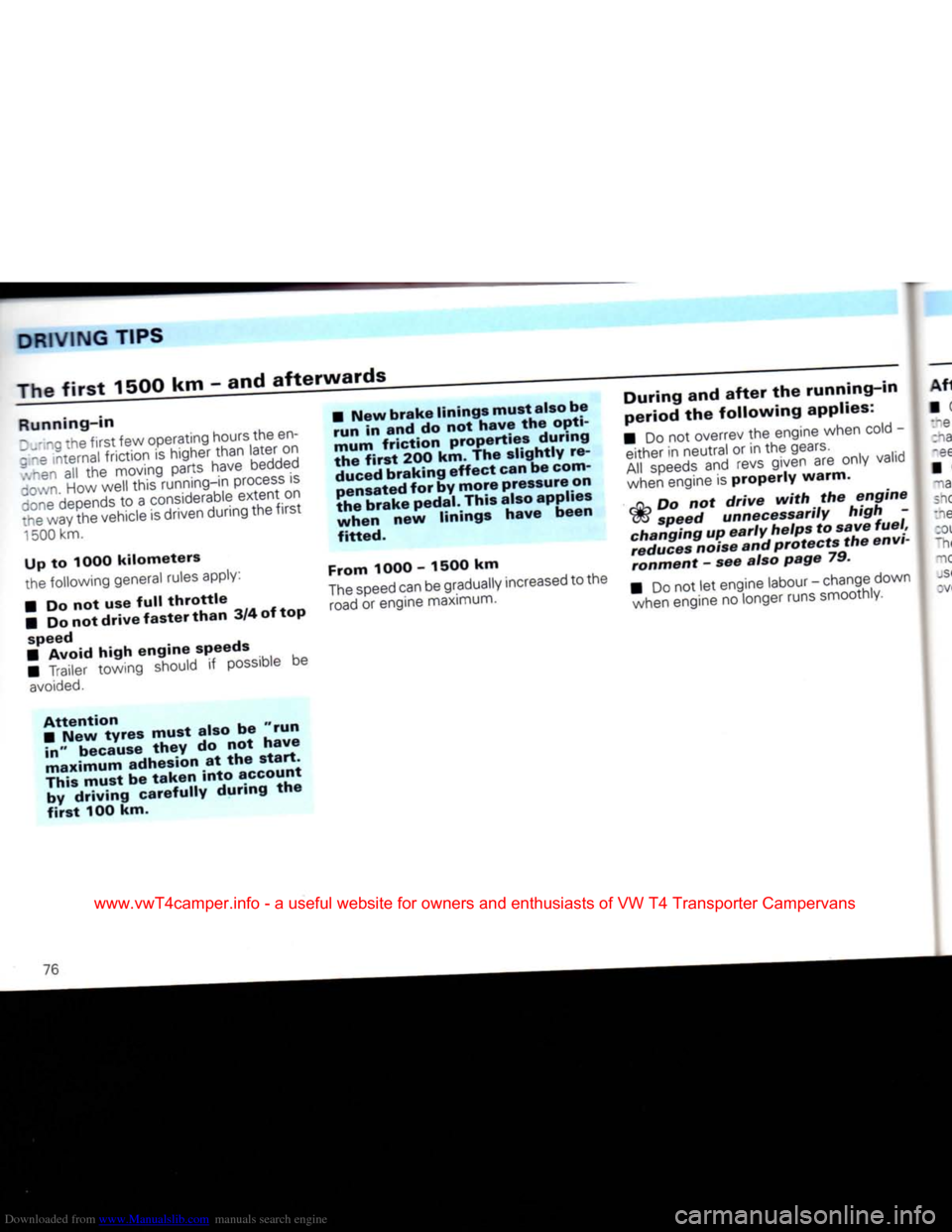
Downloaded from www.Manualslib.com manuals search engine
DRIVING
TIPS
The
first
1500 km - and
afterwards
Running-in
I/-c :he
first
few operating hours the en-
5ine
internal friction is higher than later on .-.hen all the moving parts have bedded
down.
How well this running-in process is
::cne
depends to a considerable extent on
the way the vehicle is driven during the
first
1500
km.
Up to 1000
kilometers
the following general rules apply:
• Do not use
full
throttle
• Do not
drive
faster
than
3/4 of top speed
• Avoid
high
engine
speeds
• Trailer towing should if possible be
avoided.
Attention
• New
tyres
must
also be "run in" because
they
do not
have
maximum
adhesion at the
start.
This
must
be
taken
into
account by
driving
carefully
during
the
first
100 km. • New
brake
linings
must
also be
run in and do not
have
the opti
mum
friction
properties
during
the
first
200 km. The
slightly
re duced
braking
effect
can be com
pensated
for by
more
pressure on
the
brake
pedal. This also applies
when
new linings
have
been
fitted.
From 1000 - 1500 km
The
speed can be gradually increased to the road or engine maximum.
During
and
after
the
running-in
period
the
following
applies:
• Do not overrev the engine when cold - either in neutral or in the gears.
All
speeds and revs given are only valid
when engine is
properly
warm.
Do not
drive
with
the
engine
speed
unnecessarily
high
changing
up
early
helps
to
save
fuel,
reduces
noise
and
protects
the
envi
ronment
- see
also
page
79.
• Do not let engine labour - change down when engine no longer runs smoothly.
76
www.vwT4camper.info - a useful website for owners and enthusiasts of VW T4 Transporter Campervans
Page 80 of 164
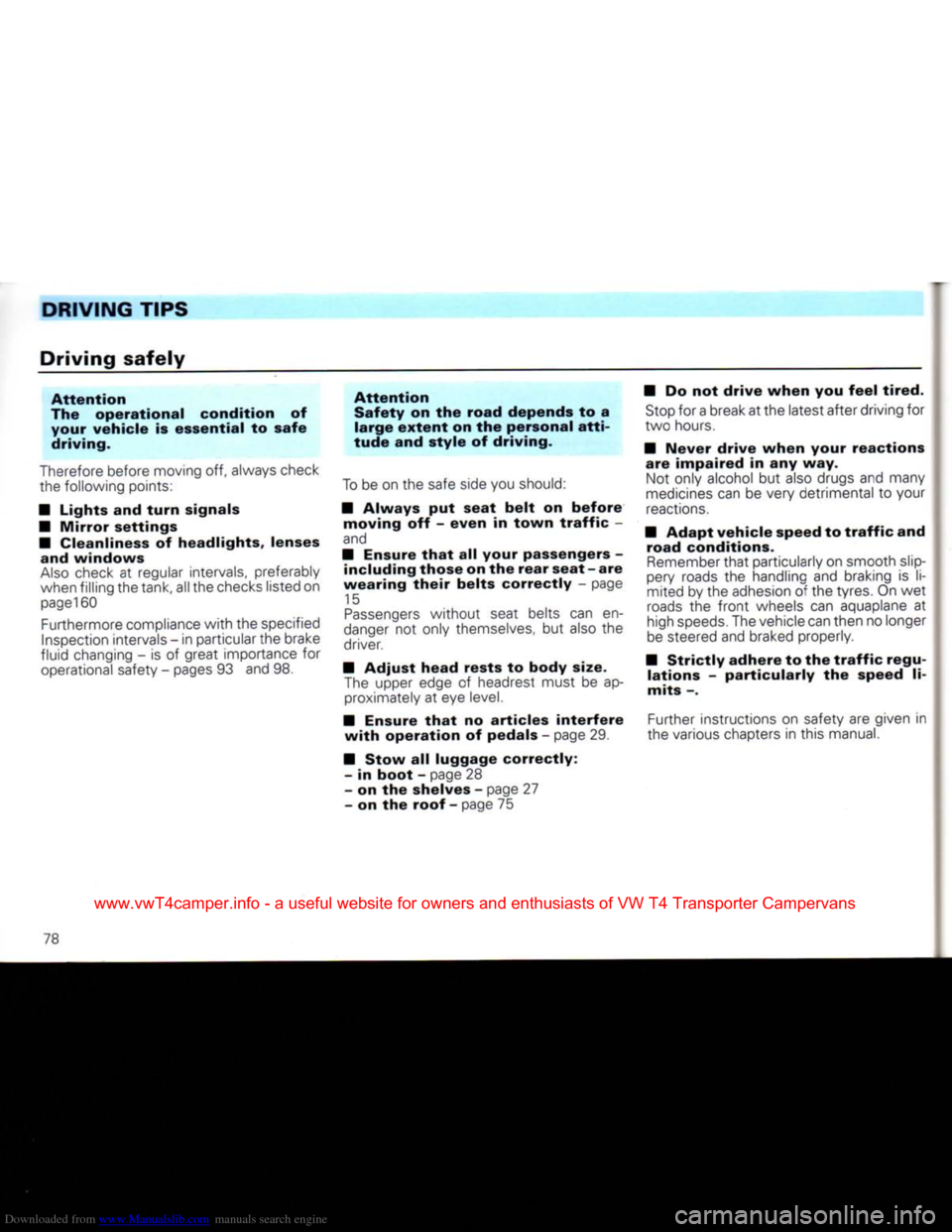
Downloaded from www.Manualslib.com manuals search engine
DRIVING
TIPS
Driving
safely
Attention
The
operational
condition of your
vehicle
is
essential
to
safe
driving.
Therefore before moving off, always check
the following points:
• Lights and
turn
signals
•
Mirror
settings
• Cleanliness of
headlights,
lenses and
windows
Also
check at regular intervals, preferably
when filling the tank, all the checks listed on
page160
Furthermore compliance
with
the specified Inspection intervals - in particular the brake
fluid changing - is of great importance for operational safety - pages 93 and 98.
Attention
Safety
on the
road
depends to a
large
extent
on the personal
atti
tude
and
style
of driving.
To
be on the safe side you should:
•
Always
put
seat
belt
on
before
moving
off -
even
in
town
traffic
-
and
• Ensure
that
all your passengers - including
those
on the
rear
seat
- are
wearing
their
belts
correctly
- page
15
Passengers
without seat belts can en
danger
not only themselves, but also the
driver.
•
Adjust
head
rests
to body size.
The
upper edge of headrest must be approximately at eye
level.
• Ensure
that
no
articles
interfere
with
operation
of pedals - page 29
•
Stow
all
luggage
correctly:
- in
boot
- page 28
- on the shelves - page 27
- on the
roof
- page 75 • Do not
drive
when
you
feel
tired.
Stop
for a break at the latest after driving for
two hours.
•
Never
drive
when
your
reactions
are
impaired
in any way. Not only alcohol but also drugs and many
medicines
can be very detrimental to your
reactions.
•
Adapt
vehicle
speed to
traffic
and
road
conditions.
Remember
that
particularly on smooth slip
pery roads the handling and braking is li
mited by the adhesion of the tyres. On wet
roads
the
front
wheels can aquaplane at
high
speeds.
The vehicle can then no longer
be
steered and braked properly.
•
Strictly
adhere
to the
traffic
regu
lations
-
particularly
the speed li
mits
-.
Further instructions on safety are given in
the various chapters in this manual.
78
www.vwT4camper.info - a useful website for owners and enthusiasts of VW T4 Transporter Campervans
Page 81 of 164
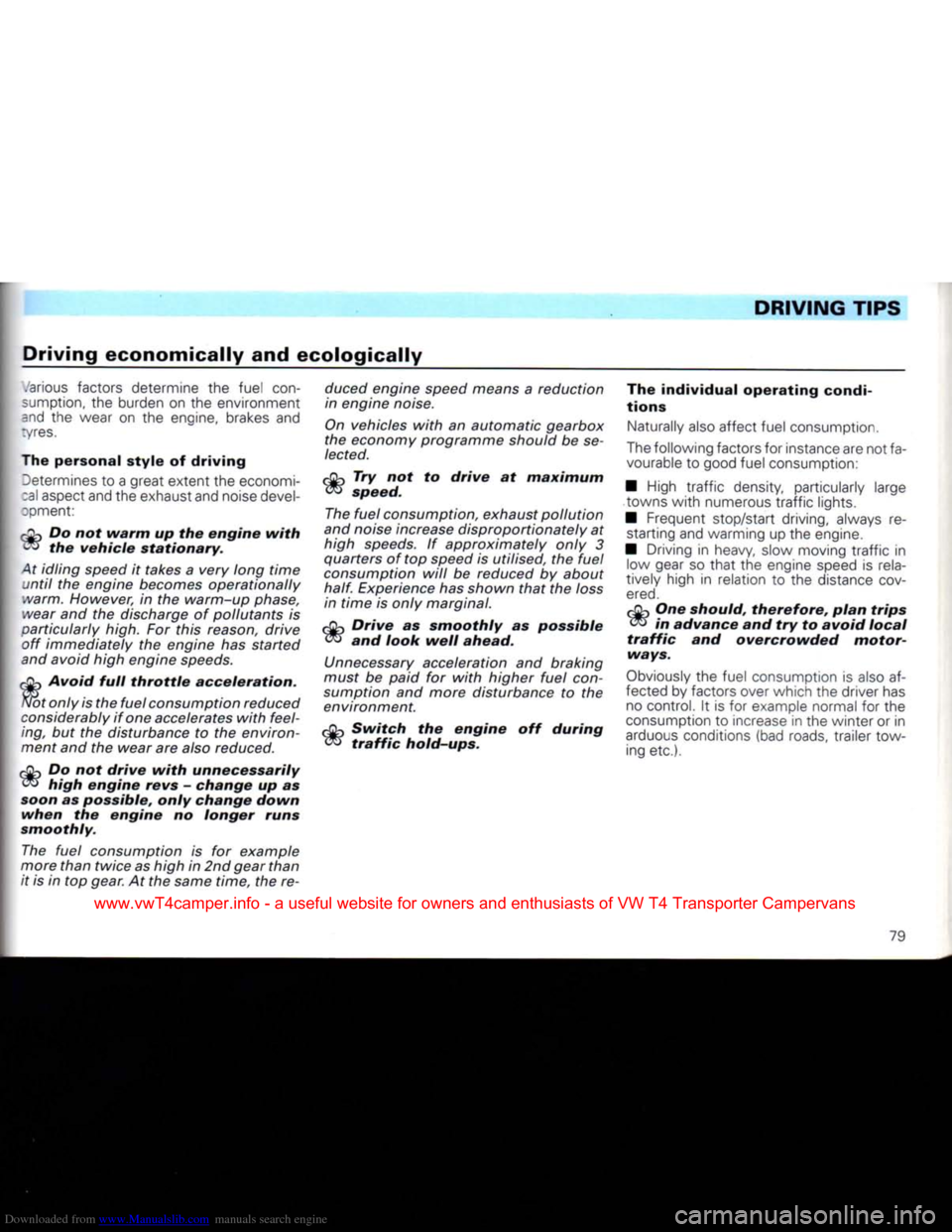
Downloaded from www.Manualslib.com manuals search engine
DRIVING
TIPS
Driving economically and ecologically
.'arious
factors determine the fuel
con
sumption,
the burden on the environment
and
the wear on the engine, brakes and
lyres.
The personal style of driving
Determines
to a great extent the economi-
:al
aspect and the exhaust and noise
devel
opment:
jOp
Do not
warm
up the
engine
with
W» the
vehicle
stationary.
At idling speed it takes a very long
time
until
the engine becomes operationally
warm. However, in the warm-up phase,
wear and the discharge of pollutants is
oarticularly high. For
this
reason, drive
off immediately the engine has started
and avoid
high
engine speeds.
f
h Avoid
full
throttle
acceleration.
of only is the
fuel
consumption reduced
considerably
if one accelerates
with
feel
ing, but the disturbance to the environ
ment
and the wear are also reduced.
rflri
Do not
drive
with
unnecessarily
high
engine
revs
-
change
up as
soon as possible,
only
change
down
when
the
engine
no
longer
runs
smoothly.
The
fuel
consumption is for example
more
than
twice as
high
in 2nd gear
than
it is in top
gear.
At the same
time,
the re duced engine speed means a reduction
in engine noise.
On vehicles
with
an automatic gearbox
the economy programme should be se
lected.
c^p
Try not to
drive
at
maximum
TO
speed.
The
fuel
consumption, exhaust pollution
and noise increase disproportionately at
high
speeds. If approximately only 3
quarters of top speed is utilised, the
fuel
consumption
will
be reduced by about
half.
Experience has shown
that
the loss in
time
is only marginal.
c
j-,
Drive
as
smoothly
as possible and
look
well
ahead.
Unnecessary
acceleration and braking
must
be paid for
with
higher
fuel
con
sumption and more disturbance to the environment.
Switch
the
engine
off
during
hold-ups. The individual
operating
condi
tions
Naturally
also
affect fuel consumption.
The
following factors for instance are not fa
vourable
to good fuel consumption:
•
High traffic density, particularly large
.towns with numerous traffic lights.
•
Frequent stop/start driving, always restarting and warming up the engine.
•
Driving in heavy, slow moving traffic in
low
gear so that the engine speed is
rela
tively high in relation to the distance cov
ered.
CQ~, One
should,
therefore,
plan
trips
in
advance
and try to
avoid
local
traffic
and
overcrowded
motor
ways.
Obviously
the fuel consumption is
also
af
fected
by factors over which the driver has
no
control. It is for example normal for the
consumption
to increase in the winter or in
arduous
conditions (bad roads, trailer tow ing etc.).
79
www.vwT4camper.info - a useful website for owners and enthusiasts of VW T4 Transporter Campervans
Page 82 of 164

Downloaded from www.Manualslib.com manuals search engine
DRIVING
TIPS
The technical
prerequisites
"or
a low fuel consumption and efficiency were "built in" at the factory. Particular im
portance was placed on the lowest possible
disturbance
to the environment. To retain
and
make the best possible use of these
characteristics
attention should be paid to
the following points:
Vehicles
fitted
with
a
catalytic
converter
may
only
be
driven
on
unleaded
petrol.
Even
those
vehicles
which
do
not
have
a
catalytic
converter
should
be
driven
on
unleaded
petrol
for the
sake
of the
environment.
The
prescribed
maintenance
operations
should
be
carried
out
exactly
as
specified
in the
Service
Schedule - see
also
page
93.
Having your vehicle regularly serviced by
a Volkswagen dealer not
only
ensures
that
it is always operationally fit, but it
also ensures economy, lowest possible burden on the environment and a long
service
life.
Check the
tyre
pressures
every
4
weeks.
Low
tyre
pressures increase the rolling
resistance.
This not
only
increases the
fuel
consumption and
tyre
wear,
but the
handling is also impaired.
Do not
carry
unnecessary
ballast
in the
luggage
boot
Particularly in
town
traffic
when one has to accelerate
often,
weight
has a
great
in
fluence on the
fuel
consumption. As a
rule
of
thumb:
For every 100 kg of
weight
the consumption increases by approxi
mately
litre
per 100 km.
Remove
roof
rack
immediately
after
use
Particularly at
high
speeds the increased
air resistance makes
itself
felt
consider
ably.
gCK
Electrical
consumers
should
only
be
switched
on
when
they
are
actually
required
Heated rear windows, additional driving
lights
and heater blower consume a con
siderable amount of
current.
The higher
alternator
load
also increases the
fuel
consumption. For instance, over a period of 10 hours, the heated rear window
will
increase
the
fuel
consumption by ap
proximately 1
litre.
Check the
fuel
consumption
reg
ularly
The
fuel
consumption should be checked
each
time
the
tank
is
filled
up. By doing
this
inconsistencies on the vehicle which
lead to an increased
fuel
consumption
can be discovered sooner.
• Check the
engine
oil
level
each
time
the
tank
is
filled
up
The
oil consumption depends to a great ex
tent
on the engine load and
speed.
Depend
ing on the style of driving the consumption
can
be as much as 1.0 litres/1000 km.
It is normal for the oil consumption of a new
engine
to reach its lowest level after a cer
tain mileage has been covered. The
con
sumption cannot be properly
assessed
until
the vehicle has run approx. 5000 km.
This
also
applies to the fuel consumption
and
the engine output.
www.vwT4camper.info - a useful website for owners and enthusiasts of VW T4 Transporter Campervans
Page 83 of 164
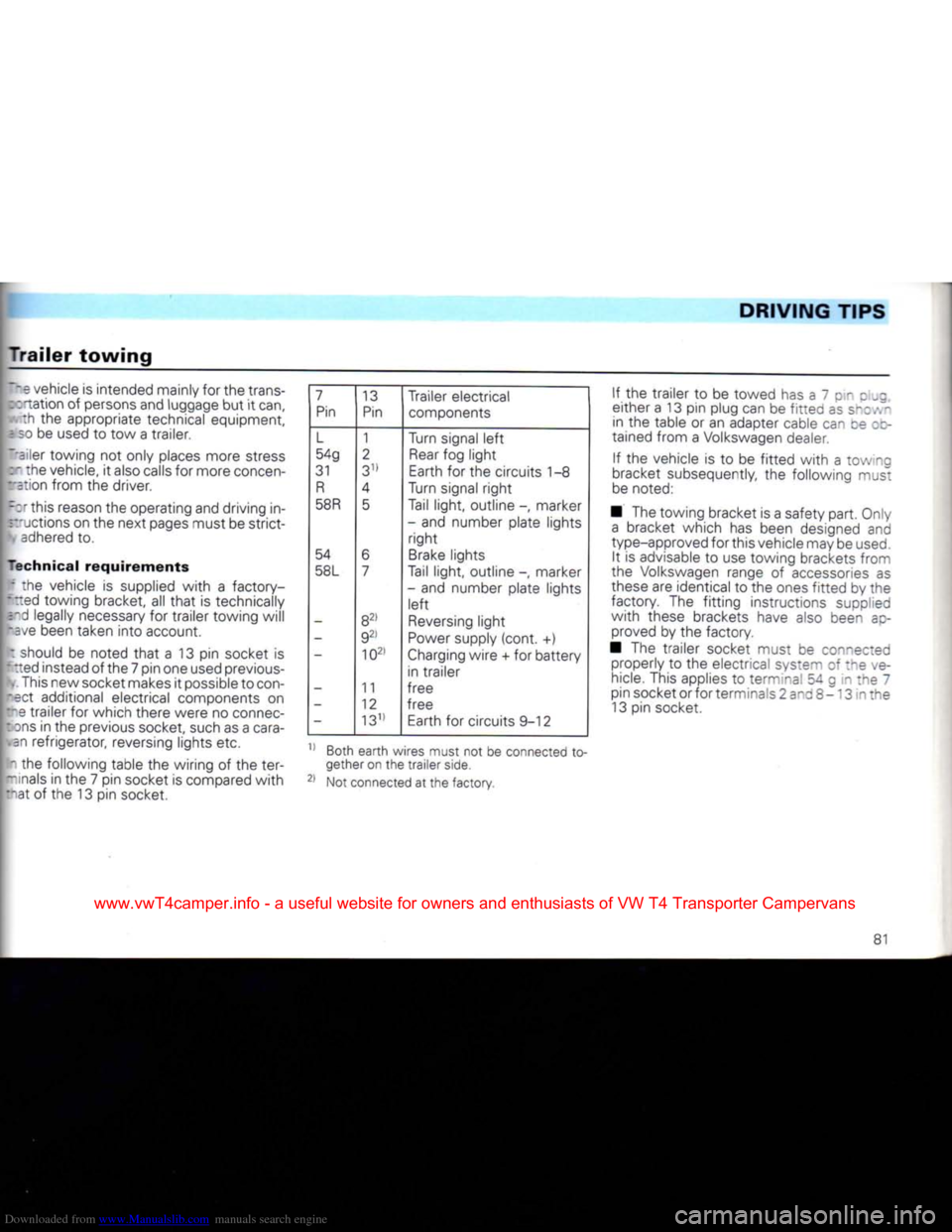
Downloaded from www.Manualslib.com manuals search engine
DRIVING
TIPS
Trailer
towing
~~e
vehicle is intended mainly for the trans-
cctation of persons and luggage but it can, th the appropriate technical equipment,
=
so be used to tow a trailer.
Ibiler towing not only places more stress : - the vehicle, it also calls for more concen-
ration from the driver.
::r this reason the operating and driving inductions on the next pages must be strict- . adhered to.
Technical
requirements
" :he vehicle is supplied
with
a factory-
• ::ed towing bracket, all
that
is technically -
d
legally necessary for trailer towing will =ve been taken into account.
: should be noted
that
a 13 pin socket is
::ed
instead of the 7 pin one used previous- . This new socket makes it possible to con-
ect additional electrical components on trailer for which there were no connec-
ns
in the previous socket, such as a
cara-
n refrigerator, reversing lights etc.
the following table the wiring of the ter-
nals
in the 7 pin socket is compared
with
at of the 13 pin socket.
I a 7
13
Trailer electrical
Pin Pin
components
L
1 Turn signal
left
54g
2
Rear
fog light
31
311
Earth
for the circuits 1-8
R
4
Turn signal
right
58
R
5
Tail
light, outline -, marker
- and number plate lights
right
54 6
Brake
lights
58L
7
Tail
light, outline -, marker
- and number plate lights
left
- 82>
Reversing
light
-
92!
Power
supply (cont. +)
-
102!
Charging
wire + for battery
in trailer
- 11
free
- 12
free
-
1311
Earth
for circuits 9-12
1) Both earth wires must not be connected to gether on the trailer side.
21 Not connected at the factory. If the trailer to be towed has a 7 pin plug,
either a 13 pin plug can be
fitted
as shown
in the table or an adapter cable can ce zz-
tained from a Volkswagen dealer.
If the vehicle is to be
fitted
with
a towing
bracket subsequently, the following must
be
noted:
• The towing bracket is a safety part. Only
a
bracket which has been designed and
type-approved for this vehicle may be
used.
It is advisable to use towing brackets from
the Volkswagen range of accessories as
these
are identical to the ones
fitted
by the
factory. The
fitting
instructions supplied
with
these brackets have also been ap proved by the factory.
• The trailer socket must be connected properly to the electrical system of the ve
hicle.
This applies to terminal 54 g in the 7
pin socket or for terminals 2 and 8 -13 in the
13
pin socket.
81
www.vwT4camper.info - a useful website for owners and enthusiasts of VW T4 Transporter Campervans